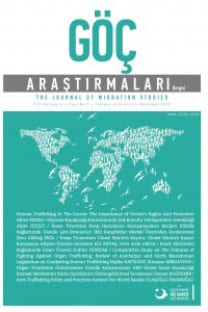Göçmenlerin Sosyal Uyum Politikaları Üzerine Güncel Bir Değerlendirme: İspanya Örneği
Göçmen, Uyum, Çeşitlilik, Yönetim
A Current Evaluation on Social Cohesion Policies of Immigrants: The Case of Spain
Immigrant, Integration, Diversity, Management,
___
- Alba, R., & Nee, V. (1997). Rethinking Assimilation Theory for a New Era of Immigration. International Migration Review 4(31), 826-874.
- Arango, J. (2013). Exceptional in Europe?, Spain’s Experience with Immigration and Integration. Washington, DC: Migration Policy Institute. Obtenido de https://www.migrationpolicy.org/pubs/TCM-Spaincasestudy.pdf
- Arango, J., Mahía, R., Moya Malapeira, D., & Sánchez-Montijano, E. (2019). Anexo Infográfico. En F. Fàbregues , & O. Farrés, Político, Inmigración y Compartamiento Político. Barcelona: CIDOB.
- Ares, A. (2007). La Rueca Migratoria: Tejiendo historias y experiencias de integración. Madrid: Universidad Pontificia Comillas.
- Bertelsmann Sustainable Governance Indicators. (2020). Spain Report. Obtenido de https://www.sgi-network.org/2020/Spain
- Buceta Facarro, L. (2006). Inmigración e Integración. Seminario de Pensamiento y Análisis de la Sociedad Social León, XIII, No.7 (págs. 149-188). Madrid: Centro de Estudios Ramón Areces, S.A.
- Cachón Rodríguez, L. (2009). La "España inmigrante": marco discriminatorio, mercado de trabajo y políticas de integración. Barcelona: Anthropos.
- Cachón, L. (2009). La «España inmigrante»: marco discriminatorio, mercado de trabajo y políticas de integración. Barcelona: Anthropos.
- Canal , J., & Rodríguez, C. (2009). Analysis of wage differences between native and immigrant workers in Spain. Spanish Economical Review, 10, 109-134.
- Carrasco Carpio, C., & García-Serrano, C. (2015). Efectos de la crisis en la estructura ocupacional y la biografia laboral de la población inmigrante. Migraciones. Publicación Del Instituto Universitario De Estudios Sobre Migraciones, (37), 75-96.
- Castles, S., Korac, M., Vasta, E., & Vertovec, S. (2002). Integration: Mapping the Field. London: Home Office.
- CES. (2019). La Inmigración en España: Efectos y Oportunidades. Madrid: Consejo Económico y Social España. Departamiento de Publicaciones.
- Chiswick, B. (1978). The Effect of Americanization in the Earnings of Foreign Born Men. Journal of Political Economy, 86, 897-921.
- Eurostat. (2021). Statistical Office of the European Commun. Obtenido de Migrant integration statistics-active citizenship: https://ec.europa.eu/eurostat/statistics-explained/index.php?title=Migrant_integration_statistics_-_active_citizenship#Long-term_residence_permits_for_non-EU_citizens
- Gobierno de España. (30 de Junio de 2020). Ministerio de Inclusión, Seguridad Social Y Migraciones. Obtenido de http://extranjeros.mitramiss.gob.es/es/estadisticas/operaciones/con-certificado/index.html IOM. (2019). International Migration Law, Glossary on Migration. Obtenido de International Organization for Migration: www.iom.int
- Javed, K., Bidart, T., & Todorosvka, I. Z. (2019). Access to Education For Refugee and Migrant Children in Europe. UNHCR, UNICEF, IOM.
- Kaya, E. (2021). Avrupa Birliği’nde Toplumsal Cinsiyet ve Göç: İspanya Örneği. En B. Oktay Yılmaz, S. Altınbaş, Ç. Çelik, O. Ünlü, S. Gezegen Ünlü, & S. Batuk, Avrupa Birliği’nin Toplumsal Cinsiyet Eşitliği Politikalarına Yönelik Güncel Tartışmalar (págs. 157-179). İstanbul: Filiz Kitabevi.
- Kymlicka, W. (2001). Politics in the Vernacular: Nationalism, Multiculturalism, and Citizenship. Oxford: Oxford University Press.
- Massey, D. (2008). Categorically Unequal: The American Stratification System. New York : Russell Sage Foundation.
- Massey, D., Alarcón, R., Durand, J., & González, H. (1990). Return to Aztlan: The Social Process of International Migration from Western Mexico . Berkeley: University of California Press.
- Ministerio de Empleo y Seguridad Social. (2012). Presupuesto General 2012. Madrid: Ministerio de Empleo y Seguridad Social.
- Ministerio de Inclusión, S. S. (Agosto de 2017). Obtenido de https://extranjeros.inclusion.gob.es/es/informacioninteres/informacionprocedimientos/ciudadanosnocomunitarios/hoja012/index.html
- Ministerio de Trabajo e Inmigración. (2010). Presupuesto General 2011. Madrid: Ministerio de Trabajo e Inmigración.
- MIPEX. (2020). Obtenido de Migrant Integration Policy Index: https://www.mipex.eu/spain
- OECD. (2020). International Migration Outlook 2020. Obtenido de https://read.oecd-ilibrary.org/social-issues-migration-health/international-migration-outlook-2020_ec98f531-en
- Öztürk, Ö. G. (2016). İspanya Göç Politikaları ve Göçmen Hayatlar: İspanya Örneği Türkiye İçin Bir Model Olabilir mi? Nüfusbilim Dergisi, 103–135.
- Pennix, R. (2007). Integration Processes of Migrants: Research Findings and Policy Challenges. Migration and Ethnic Themes, 7-32.
- Rinken, S. (2015). Actitudes hacia la inmigración y los inmigrantes. ¿En que es España exepcional? Migraciones, 37., 53-74.
- Serrano, J. P., Iglesias, M., & Fernandéz Alle, J. (2012). İspanya Ülke Raporu: İspanya Göç Veren Bir Ülkeden Bir Göçmenler Ülkesine. En A. İçduygu, K. Biehl, & vd., Kentler ve Göç: Türkiye, İtalya, İspanya Örnekleri (págs. 243-296). İstanbul: İstanbul Bilgi Üniversitesi.
- Türk Dil Kurumu. (25 de 04 de 2022). Obtenido de https://sozluk.gov.tr/
- ISSN: 2149-5548
- Başlangıç: 2015
- Yayıncı: Göç İdaresi Genel Müdürlüğü
Uluslararası Toplum İçin Yeni Bir Meydan Okuma Olarak Uluslararası Göç
Göçmenlerin Sosyal Uyum Politikaları Üzerine Güncel Bir Değerlendirme: İspanya Örneği
Göçlerin Mekânın Dönüşümüne Etkisi: Güney Marmara Bölümü Örneği
İlhan Oğuz AKDEMİR, Emrah TÜRKOĞLU
GÖÇMENLERLE ÇALIŞAN HUKUKÇULARIN YAŞADIKLARI İKİNCİL TRAVMATİK STRES
Yağmur Melis SÖZER, Şebnem AKİPEK ÖCAL
GÖÇMEN ENTEGRASYONU VE TANINMA TEORİSİ “ADİL ENTEGRASYON” Kitap İncelemesi
